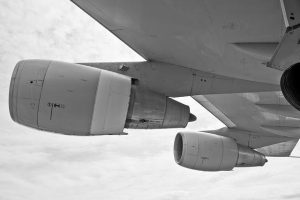
Turbofans are one of the most common types of jet engines. They are propulsion systems that burn fuel and air. From the Boeing 787 to the Airbus A850, some of the world’s most popular commercial airliners are powered by turbofans.
The Basics of Turbofans
Turbofans are jet engines that leverage a gas turbine to drive a fan. Also known as fanjets, they generate propulsion via a combustion chamber and fan.
How Turbofans Work
Turbofans work by burning fuel and air — a process that’s known as combustion — and driving a fan. All engines, of course, generate propulsion. While other engines may rely strictly on combustion to generate propulsion, turbofans use both combustion and a fan to generate propulsion.
The fan in a turbofan may feature a single stage, or it may feature multiple stages. Regardless, the fan is designed to “push” air out the back of the turbofan.
Turbofans still burn fuel and air. All jet engines, in fact, involve the use of combustion to generate propulsion. Burning these substances creates pressurized exhaust gases. As these exhaust gases are ejected out of the jet engine, they will propel the airplane forward. Turbofans follow this same process, but they feature a fan as well. Turbofans use combustion and a fan to generate propulsion.
The Different Types of Turbofans
Not all turbofans are the same. By definition, a turbofan is simply a jet engine that uses combustion and a fan to generate propulsion. But there are different types of turbofans, each of which features a unique design.
Low-bypass turbofans are those with a low bypass ratio. They are typically restricted to high-speed jet airplanes, such as military jets and supersonic jets. Low-bypass turbofans have a high pressure ratio, resulting in high exhaust velocity.
Afterburning turbofans are those with a low-to-medium bypass ratio. They feature a combustor that burns fuel from the fuel injectors.
High-bypass turbofans, as you may have guessed, are characterized by a high bypass ratio. Of all three types listed here, high-bypass is the most common. They’ve been around for over a half-century. During that time, aerospace manufacturers have perfected high-bypass turbofans. High-bypass turbofans are powerful, efficient and reliable.
In Conclusion
Many commercial airliners feature turbofans. Turbofans are essentially airbreathing jet engines. They burn a mixture of fuel and air, but they also suck in air to spin a fan. This fan will force the air out the back of the turbofan.



